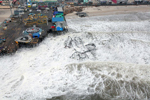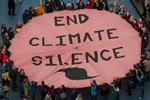
Hurricane Sandy storm surge on the New Jersey shore. Photo by: Master Sgt. Mark C. Olsen/U.S. Air Force/New Jersey National Guard.
Sea levels are rising 60 percent faster than Intergovernmental Panel on Climate Change (IPCC) has estimated, according to a new study in the open access Environmental Research Letters. In addition to imperiling coastal regions and islands, global sea level rise is worsening the damage inflicted by extreme weather such as Hurricane Sandy, which recently brought catastrophic flooding to the New Jersey coast and New York City.
“This study shows once again that the IPCC is far from alarmist, but in fact has under-estimated the problem of climate change,” lead author of the study, Stefan Rahmstorf, said. “That applies not just for sea-level rise, but also to extreme events and the Arctic sea-ice loss.”
According to the study, global sea levels have begun to rise around 3.2 millimeters every year, as opposed to the “best estimate” in the last IPCC report of 2 millimeters. Climate change is pushing seas higher due to melt water from shrinking glaciers and ice sheets as well as the fact that warmer water physically expands.
While the study finds that the IPCC’s predictions on rising atmosphere CO2 and temperature rise are generally accurate, the scientific group’s projections on sea level rise “may be systematically biased low,” the researchers write.
“In contrast to the physics of global warming itself, sea-level rise is much more complex,” Rahmstorf explains. “To improve future projections it is very important to keep track of how well past projections match observational data.”
Climate denialists have often attacked the IPCC for its predictions, but most observed impacts of climate change are in fact meeting or exceeding IPCC estimates. Slowing sea level rise requires cutting greenhouse gases that trap heat in the atmosphere and warm the Earth. The next IPCC report will be released in 2013 and 2014.
CITATION: Rahmstorf, S, Foster, G., Cazenave, A. (2012). Comparing climate projections to observations up to 2011. Environmental Research Letters 7 044035 (doi:10.1088/1748-9326/7/4/044035).
Related articles
China and India plan 818 new coal plants
(11/26/2012) Even as the clamor to reduce greenhouse gas emissions reaches a new high—echoed recently by such staid institutions as the World Bank and the International Energy Agency (IEA)—a new analysis by the World Resources Institute (WRI) finds that 818 new coal-fired plants are under proposal in China and India. In all 1,199 new coal-fired plants are currently planned worldwide, according to the report, totaling 1.4 million megawatts of energy.
As Doha Climate Summit kicks off, more ambitious cuts to greenhouse gas emissions needed
(11/26/2012) As the 18th meeting of the UN Framework Convention on Climate Change (UNFCCC) kicks off this morning in oil and gas rich Qatar, the world body warns that much more ambitious greenhouse gas cuts are needed to keep catastrophic climate change at bay. A new report by the UN Environment Program (UNEP) and the European Climate Foundation finds that even if all current emissions pledges are kept, the world will still spew 8 billion tonnes of CO2 equivalent above what is needed by 2020, putting the globe on a fast-track to dangerous climate change.
Forests worldwide near tipping-point from drought

(11/23/2012) Forests worldwide are at ‘equally high risk’ to die-off from drought conditions, warns a new study published this week in the journal Nature. The study, conducted by an international team of scientists, assessed the specific physiological effects of drought on 226 tree species at 81 sites in different biomes around the world. It found that 70 percent of the species sampled are particularly vulnerable to reduction in water availability. With drought conditions increasing around the globe due to climate change and deforestation, the research suggests large swathes of the world’s forests — and the services they afford — may be approaching a tipping point.
Hotter and hotter: concentrations of greenhouse gases hit another new record
(11/20/2012) As expected, greenhouse gas concentrations in the Earth’s atmosphere hit another record last year, according to a new UN World Meteorological Organization (WMO). The increasing concentrations of greenhouse gases means that radiative forcing—changes in the atmosphere’s energy balance that leads to warming—has jumped 30 percent in the last twenty years.
World Bank: 4 degrees Celsius warming would be miserable

(11/20/2012) A new report by the World Bank paints a bleak picture of life on Earth in 80 years: global temperatures have risen by 4 degrees Celsius spurring rapidly rising sea levels and devastating droughts. Global agriculture is under constant threat; economies have been hampered; coastal cities are repeatedly flooded; coral reefs are dissolving from ocean acidification; and species worldwide are vanishing. This, according to the World Bank, is where we are headed even if all of the world’s nations meet their pledges on cutting greenhouse gas emissions. However, the report also notes that with swift, aggressive action it’s still possible to ensure that global temperatures don’t rise above 4 degrees Celsius.
Asian cities face high disaster risk with 650,000 killed in 2000’s
(11/16/2012) Asia’s cities are increasing vulnerable to natural disasters due to climate change, urban expansion, and poor planning, warns a report published this week by the Asian Development Bank. Disasters risk undermining recent economic gains in the region.
Obama criticized for lack of urgency on climate change
(11/15/2012) Following the devastation wrought by Hurricane Sandy—which many scientists say was likely worsened by climate change—and a long silence on the issue of global warming during the Presidential campaign, environmentalists yesterday were disappointed when re-elected President Barack Obama seemingly put action on climate change on the back burner.
It’s not just Sandy: U.S. hit by record droughts, fires, and heatwaves in 2012

(11/05/2012) As the devastation wrought by Hurricane Sandy—killing over 100 people and producing upwards of $50 billion in damage along the U.S. East Coast—has reignited a long-dormant conversation on climate change in the media, it’s important to note that this is not the only weird and wild weather the U.S. has seen this year. In fact, 2012 has been a year of record-breaking weather across the U.S.: the worst drought in decades, unprecedented heatwaves, and monster forest fires. While climatologists have long stated that it is not yet possible to blame a single extreme weather event on climate change, research is showing that rising temperatures are very likely increasing the chances of extreme weather events and worsening them when they occur.
After defeating coal plant, Borneo hosts renewable energy meeting
(10/31/2012) Last year, a coalition of environmentalists and locals won a David-versus-Goliath battle against a massive coal plant in the Malaysian state of Sabah on Borneo. After facing a protracted campaign—including expert analysis of green energy options for Sabah—the state government announced it was scuttling plans to build the coal plant on a beach overlooking the Coral Triangle. Now, victorious grassroots campaigners are hosting the inaugural meeting of the Southeast Asia Renewable Energy People’s Assembly (SEAREPA), bringing 80 organizations together to discuss green energy options across southeast Asia.
Hours before Hurricane Sandy hit, activists protested climate inaction in Times Square

(10/30/2012) On Sunday, as Hurricane Sandy roared towards the coast of the Eastern U.S., activists took to the streets in New York City to highlight the issue of climate change. Activists organized by 350.org unfurled a huge parachute in Times Square with the words, “End Climate Silence,” a message meant to call attention to the fact that there has been almost zero mention of climate change during the presidential campaign, including not a single reference to the issue in the four presidential debates.
How climate change may be worsening Hurricane Sandy

(10/29/2012) While scientists are still debating some fundamental questions regarding hurricanes and climate change (such as: will climate change cause more or less hurricanes?), there’s no debating that a monster hurricane is now imperiling the U.S. East Coast. A few connections between a warmer world and Hurricane Sandy can certainly be made, however: rising sea levels are likely to worsen storm surges; warmer waters bring more rain to increase flooding; and hotter temperatures may allow the hurricane to push both seasonal and geographic boundaries.
Will we need to pull carbon out of the atmosphere to save ourselves?

(10/17/2012) This year saw the Arctic sea ice extent fall to a new and shocking low, while the U.S. experienced it warmest month ever on record (July), beating even Dust Bowl temperatures. Meanwhile, a flood of new research has convincingly connected a rise in extreme weather events, especially droughts and heatwaves, to global climate change, and a recent report by the DARA Group and Climate Vulnerability Forum finds that climate change contributes to around 400,000 deaths a year and costs the world 1.6 percent of its GDP, or $1.2 trillion. All this and global temperatures have only risen about 0.8 degrees Celsius (1.44 degrees Fahrenheit) since the early Twentieth Century. Scientists predict that temperatures could rise between 1.1 degrees Celsius (2 degrees Fahrenheit) to a staggering 6.4 degrees Celsius (11.5 degrees Fahrenheit) by the end of the century.